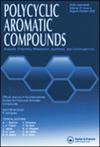Numerous Heterocyclic Compounds with an Isonicotinic Moiety have Been Studied for Their Synthesis, Antibacterial, Anticancer, Docking Simulation, and DFT Characteristics
IF 2.4
3区 化学
Q2 CHEMISTRY, ORGANIC
引用次数: 0
Abstract
In this elucidation, we focused on the synthesis of isonicotinic heterocyclic molecules through reaction of isonicotinic acid hydrazide with phthalic anhydride, which produced an excellent yield of the equivalent N-(1,3-dioxoisoindolin-2-yl)isonicotinamide (3), and isonicotinic acid hydrazide can react easily with different aldehydes to form derivatives of Schiff bases. Furthermore, the reactivity of hydrazide with CS2 which cyclized in the presence of acid to give the corresponding 1,3,4-oxadiazole in derivative 7, and the presence of NH2NH2 produced a 1H-1,2,4-triazole derivative 9 that readily reacted with phenacyl bromide with the elimination of -HBr to produce 6-phenyl-3-(pyridine-4-yl)-7H-[1,2,4]triazolo[3,4-b][1,3,4]thiadiazine (11). Hydrazide 1 reacts readily with many methylene compounds to produce a wide range of heterocycles. The presence of each produced heterocyclic was confirmed by spectral analysis investigation. Moreover, the synthesized compounds exhibited antimicrobial and antitumor activity against HepG2 liver tumor cells and neck squamous cell carcinoma (HNSCC) cancer cells, and the result was confirmed with different proteins through molecular docking simulation. Moreover, the optimization of the nicotinic compounds with DFT/B3LYP-631(G) basis set and determination of their physical descriptors correlated for its biological evaluation.
研究了许多具有异烟酸分子的杂环化合物的合成、抗菌、抗癌、Docking 模拟和 DFT 特性
在这一阐释中,我们重点研究了异烟酸酰肼与邻苯二甲酸酐反应合成异烟酸杂环分子的过程,该反应产生了等效的N-(1,3-二氧代异吲哚啉-2-基)异烟酰胺(3),且异烟酸酰肼很容易与不同的醛反应生成希夫碱的衍生物。此外,酰肼与 CS2 反应,在酸的存在下环化生成相应的 1,3,4-噁二唑衍生物 7,在 NH2NH2 的存在下生成 1H-1,2,4-三唑衍生物 8、2,4-三唑衍生物 9,该衍生物很容易与苯甲酰溴反应并消除 -HBr 生成 6-苯基-3-(吡啶-4-基)-7H-[1,2,4]三唑并[3,4-b][1,3,4]噻二嗪 (11)。酰肼 1 很容易与许多亚甲基化合物发生反应,生成各种杂环。光谱分析研究证实了所生成的每个杂环的存在。此外,合成的化合物对 HepG2 肝肿瘤细胞和颈部鳞状细胞癌(HNSCC)癌细胞具有抗菌和抗肿瘤活性,并通过分子对接模拟与不同的蛋白质证实了这一结果。此外,利用 DFT/B3LYP-631(G) 基集对烟碱类化合物进行了优化,并确定了它们的物理描述因子,从而为其生物学评价提供了相关信息。
本文章由计算机程序翻译,如有差异,请以英文原文为准。
求助全文
约1分钟内获得全文
求助全文
来源期刊

Polycyclic Aromatic Compounds
化学-有机化学
CiteScore
3.70
自引率
20.80%
发文量
412
审稿时长
3 months
期刊介绍:
The purpose of Polycyclic Aromatic Compounds is to provide an international and interdisciplinary forum for all aspects of research related to polycyclic aromatic compounds (PAC). Topics range from fundamental research in chemistry (including synthetic and theoretical chemistry) and physics (including astrophysics), as well as thermodynamics, spectroscopy, analytical methods, and biology to applied studies in environmental science, biochemistry, toxicology, and industry. Polycyclic Aromatic Compounds has an outstanding Editorial Board and offers a rapid and efficient peer review process, as well as a flexible open access policy.
 求助内容:
求助内容: 应助结果提醒方式:
应助结果提醒方式:


